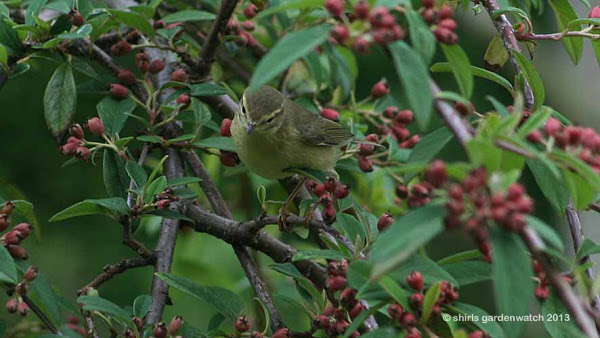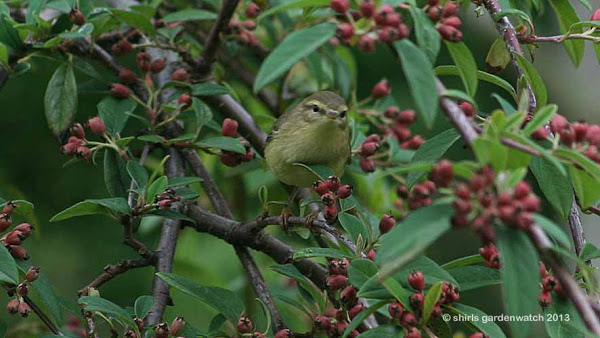The brief flash of yellow through dense green foliage outside my gardenwatching window signalled only one bird on Saturday morning! Now… I doubt it was the same bird I have seen pass through this same border, at around the same time of year, in the past two years (I suspect heading South on migration) but I am sure on ID this time 🙂
The Chiffchaff is very similar in appearance to the Willow warbler and very often it is pretty difficult to tell them apart. As they both quickly bounce their way through shrubs and dense planting (probably looking for insects to feed on) glimpses of these birds in a garden are exactly that – glimpses!
Not expecting to see anything out of the ordinary on Saturday morning (peanut feeders heavily laden with House Sparrows and Starlings) as I sat doing a bird count over breakfast, I took my video camera off the tripod. What a shame that was, I’d have loved to capture a piece of video footage of a Willow warbler visiting my garden as a record. However, I did have my still camera on the tripod… and I could reach it in time 😉
The big question now is… how do you tell the difference between a Willow warbler and a Chiffchaff? During my blogging years, I have found leg colour is always a good place to start. If you scroll back up to the photos above and look at the legs in the first three images you will see that they are pale in colour (almost pink tinged) making this bird a Willow warbler. The legs of the Chiffchaff are dark in colour (blackish) so you now have clue number one.
Clue number two (if you have a series of photos to look more closely) is the shape of the head. The last photo above shows that the Willow warbler has a fairly flat head where the Chiffchaff has a much rounder head. Okay, that’s not such an easy clue I grant you.
Searching for images on the difference between the Willow warbler and the Chiffchaff, I came across a blog by the SWT reserve up in Montrose Basin that helped me. If you click on the link at the end of the info text it will take you to the blog with a side by side photo showing the two birds for comparison which I found interesting.
“Both species are from the Phylloscopus genera, meaning they are closely related, being reflected in their appearance. They are both small birds with slender bill and legs, short narrow tails and grey-green upper feathers. Identification is also made harder by the fact that they are always on the move, darting around the foliage, meaning even the most experienced of birdwatchers may have several willow-chaffs sightings in their notebooks. But don’t fear, there are ways to tell them apart.
The easiest way to tell the two apart is by their leg colour. Chiffchaffs have dark brown legs whilst Willow Warblers have very light brown, almost pinkish legs. There can, however, be exceptions to the rule, with some Willow Warblers having darker legs than usual, although this is uncommon. In general Willow Warblers are slightly lighter than Chiffchaffs, with their under parts being more yellow than those of the duller Chiffchaff, although this can be very hard to distinguish when they aren’t side by side.”
Scottish Wildlife Trust, Montrose Basin Blog. May 19, 2013.
For the more experienced bird watcher, I suspect it will be the songs and calls between birds that is considered the best for ID – probably before a sighting is even made. A song or call wouldn’t have helped with my garden visitor (even if I were to know it) as I was indoors. However, after reading about the ‘chiff-chaff’ sound I decided it might be interesting to look it up. You can hear the song of both the Chiffchaff and the Willow warbler below.
“If you get to know the songs of the two birds, however, then it’s usually the easiest way to tell them apart, with the two songs being noticeably different. The Chiffchaff’s song is one of the easiest to identify out of all the warbler’s with it simply repeating the sound –chiff-chaff, chiff-chaff’. The Willow Warbler in contrast has a much more melodic song, starting softly, followed by a liquid series of descending notes and usually ending in a flourish.”
Scottish Wildlife Trust, Montrose Basin Blog. May 19, 2013.
Finally, my searching for information on the Willow warbler led me to one more interesting fact on this bird and one that might explain why it is seen in the same area of my garden every time it is spotted. Okay, perhaps this is a bit of a leap in coincidence but it appears that the Willow warbler is known to be faithful to particular sites both in summer and winter. Ah… so it must be returning to my garden… what fun to think that it likes it here… even if it is just passing through 😉
Does anyone else see this behavior? Is anyone else seeing Willow warblers visiting gardens just now? If you aren’t a blogger reading this and are unable to leave a comment, please do email me using the address in my sidebar and I’ll add your comment 🙂
Extra… Extra… just found a very detailed video on identifying the Willow Warbler and Chiffchaff this morning (after post was originally published). For those that want even more details…
This is not my video, it was produced by Pete Mella. Suggest you select best quality option.
If you are short on time, here’s another video with clear narration explaining the differences between the Willow warbler and Chiffchaff by the BTO. This video has moving footage of the two birds…
This is not my video, it was produced by the BTO . Suggest you select best quality option.
This post was published by Shirley for shirls gardenwatch in August 2013.





We hear chiff chaffs regularly when out for a walk in wooded areas. The song reminds me of a squeaky wheelbarrow.
How wonderful – it's always nice to know that birds will return. You've captured a few good shots there Shirley.
I'm chock full with sparrows and starlings and little else. One faithfull male chaffinch, that is if its the same one early evening.
Can I ask Shirley, is that a Cotoneaster tree in your garden?
You can sure tell the difference in their songs. How exciting to have a Willow Warbler in your garden. It lives up to it's name in it's song. It warbles beautifully.
Hello everyone and thanks for your comments 🙂
Sue, haha… I like that description. I’ll maybe recognise the willow warbler when out now 😉
Angie, it was. I was delighted with this visitor. Thanks, one of the reasons I posted these images is a reminder for myself to look for this bird at the same time next year. You can see by the colours that day it was difficult to spot. It never stayed still long and the visit was very, very brief. I saw it though. Yes, it was a small cotoneaster tree.
Lisa, I’m sure you recognise many bird songs and calls. I should get up to speed with more. It was exciting to see this bird – it sounds like it will be as exciting to hear it sing but it will have to stay longer for us to ever hear it in the garden 🙂
What a lovely surprise visitor to have Shirl.
John, it certainly was – once again I was just lucky looking out the window at the right time 🙂